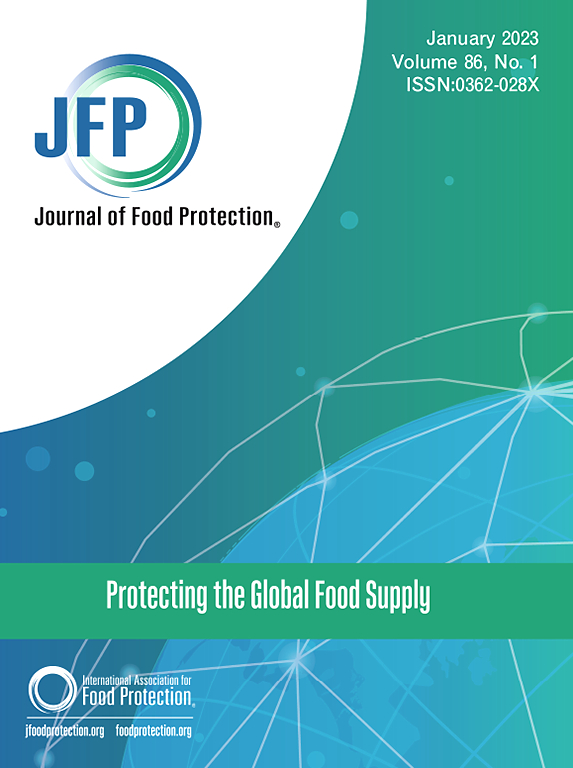Hazard Characterization of Antibiotic-resistant Aeromonas spp. Isolated from Mussel and Oyster Shellstock Available for Retail Purchase in Canada
IF 2.1
4区 农林科学
Q3 BIOTECHNOLOGY & APPLIED MICROBIOLOGY
引用次数: 0
Abstract
Surveillance and monitoring of foods for the presence of antimicrobial-resistant (AMR) bacteria are required to assess the risks these bacteria pose to human health. Frequently consumed raw or lightly cooked, live bivalve shellfish such as mussels and oysters can be a source of exposure to AMR bacteria. This study sought to determine the prevalence of third-generation cephalosporin (3GC) and carbapenem-resistant bacteria in live mussel and oyster shellstock available for retail purchase through the course of one calendar year. Just over half of the 180 samples (52%) tested positive for the presence of 3GC-resistant bacteria belonging to thirty distinct bacterial species. Speciation of the isolates was carried out using the Bruker MALDI Biotyper. Serratia spp., Aeromonas spp., and Rahnella spp. were the most frequently isolated groups of bacteria. Antibiotic resistance testing confirmed reduced susceptibility for 3GCs and/or carbapenems in 15 of the 29 Aeromonas isolates. Based on AMR patterns, and species identity, a subset of ten Aeromonas strains was chosen for further characterization by whole genome sequence analysis. Genomic analysis revealed the presence of multiple antibiotic resistance and virulence genes. A number of mobile genetic elements were also identified indicating the potential for horizontal gene transfer. Differences in gene detection by the bioinformatic tools and databases used (ResFinder. CARD RGI, PlasmidFinder, and MobSuite) are discussed. This study highlights the strengths and limitations of using genomics tools to perform hazard characterization of diverse foodborne bacterial species.
从加拿大零售的贻贝和牡蛎贝壳中分离出的抗生素耐药气单胞菌的危害特征。
要评估这些细菌对人类健康造成的风险,就必须对食品中是否存在抗微生物(AMR)细菌进行监测和监控。贻贝和牡蛎等经常生吃或轻度烹饪的活双壳贝类可能是AMR细菌的暴露源。这项研究旨在确定在一个日历年中供零售的活贻贝和牡蛎贝类中第三代头孢菌素(3GC)和碳青霉烯类耐药细菌的流行情况。在 180 个样本中,有一半多一点(52%)的样本检测结果呈阳性,显示存在对第三代头孢菌素(3GC)耐药的细菌,这些细菌属于 30 个不同的细菌种类。使用布鲁克 MALDI 生物分析仪对分离菌种进行了分类。沙雷氏菌属、气单胞菌属和拉恩氏菌属是最常分离到的细菌群。抗生素耐药性测试证实,29 个分离出的气单胞菌中有 15 个对 3GCs 和/或碳青霉烯类药物的敏感性降低。根据 AMR 模式和物种特征,选择了 10 株气单胞菌进行全基因组序列分析,以进一步确定其特征。基因组分析显示存在多种抗生素耐药性基因和毒力基因。此外,还发现了一些移动遗传因子,表明可能存在水平基因转移。本研究讨论了所使用的生物信息学工具和数据库(ResFinder、CARD RGI、PlasmidFinder 和 MobSuite)在基因检测方面的差异。本研究强调了使用基因组学工具对各种食源性细菌物种进行危害鉴定的优势和局限性。
本文章由计算机程序翻译,如有差异,请以英文原文为准。
求助全文
约1分钟内获得全文
求助全文
来源期刊

Journal of food protection
工程技术-生物工程与应用微生物
CiteScore
4.20
自引率
5.00%
发文量
296
审稿时长
2.5 months
期刊介绍:
The Journal of Food Protection® (JFP) is an international, monthly scientific journal in the English language published by the International Association for Food Protection (IAFP). JFP publishes research and review articles on all aspects of food protection and safety. Major emphases of JFP are placed on studies dealing with:
Tracking, detecting (including traditional, molecular, and real-time), inactivating, and controlling food-related hazards, including microorganisms (including antibiotic resistance), microbial (mycotoxins, seafood toxins) and non-microbial toxins (heavy metals, pesticides, veterinary drug residues, migrants from food packaging, and processing contaminants), allergens and pests (insects, rodents) in human food, pet food and animal feed throughout the food chain;
Microbiological food quality and traditional/novel methods to assay microbiological food quality;
Prevention of food-related hazards and food spoilage through food preservatives and thermal/non-thermal processes, including process validation;
Food fermentations and food-related probiotics;
Safe food handling practices during pre-harvest, harvest, post-harvest, distribution and consumption, including food safety education for retailers, foodservice, and consumers;
Risk assessments for food-related hazards;
Economic impact of food-related hazards, foodborne illness, food loss, food spoilage, and adulterated foods;
Food fraud, food authentication, food defense, and foodborne disease outbreak investigations.
 求助内容:
求助内容: 应助结果提醒方式:
应助结果提醒方式:


